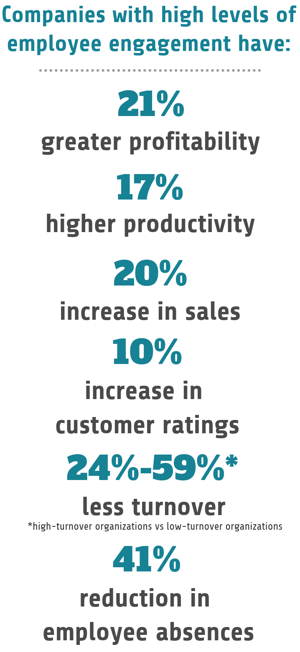
Imagine that a new employee—we’ll call him Jim—joins your team. Jim arrives early on his first day, boots up his computer and settles in to work. He has attended orientation, had a meeting or two with his manager, and bumped into some coworkers in the break room. He’s excited about his new job and ready to make a difference.
Over time, however, Jim notices some things that bother him. Document storage is a bit haphazard, so he spends a lot of time searching for things he needs. The company’s ERP and email system are outdated. They feel clunky to Jim, who is used to using intuitive consumer tech like Facebook, Amazon, and even Gmail. And on top of that, he’s not 100% sure what his manager expects of him, and he hasn’t gotten any feedback on the work he has submitted.
It’s been six months now, and Jim’s frustrations are starting to build. Work isn’t fun anymore, and Jim is starting to wonder if he made the right job decision. He’s checked out.
We’ve just described almost 70% of the American workforce today.
And that’s concerning.
The State of Employee Engagement in the Digital Workforce
 A recent Gallup poll found that just 33% of U.S. employees could be described as actively engaged. That percentage has only grown by 3% since 2001. Gallup’s survey measures things like understanding expectations, receiving recognition from a manager, working as a team, and receiving opportunities for personal growth.
A recent Gallup poll found that just 33% of U.S. employees could be described as actively engaged. That percentage has only grown by 3% since 2001. Gallup’s survey measures things like understanding expectations, receiving recognition from a manager, working as a team, and receiving opportunities for personal growth.
Another Gallup study found that companies with the highest levels of employee engagement enjoy 21% greater profitability and 17% higher productivity than those with the lowest engagement levels. They also experience higher sales, higher customer ratings, lower turnover, and fewer employee absences.
So what’s the problem? Why are two-thirds of American workers not engaged at their jobs? Gallup divides the answers into four categories:
- Basic needs
- Individual needs
- Teamwork needs
- Personal growth needs
There is also a technological component to consider. As our society has become increasingly digitized, employee expectations for the tech they use at work have risen.
That leaves us with a vital question: How can you meet these needs to promote engagement among your employees?
How Technology Can Bolster Employee Engagement in the Digital Age
Engagement studies suggest that employees are most engaged when they are happy at work and contributing to the organization. In the digital age, that means in part that the tech they use needs to help them do their jobs efficiently. Let’s take a look at some of the ways technology plays a role in engagement and retention.
- Collaborative Tools—Collaborative workplaces give employees a stronger sense of teamwork and mission. Tools like department forums, chat programs, project management tools, cloud-based file storage, and employee wikis keep everyone on the same page. They also make it easy for employees to find documents and notes related to a given project.
- Gamification—You don’t have to have elaborate leaderboards and digital badges to make gamification work for you. The premise is that real-time feedback about progress toward targets provides motivation to improve and compete for rewards. Gamification is especially effective in contexts where output is the measure of success (i.e., sales per week, calls per day, number of tickets cleared, etc.) or in training contexts.
- BYOD—Bring Your Own Device policies allow employees to use the devices they are familiar with for work as well as personal use. In fact, 70% of HR professionals see better performance from millennials when they are permitted to use their personal devices.
- Bots and AI—New AI tools like chatbots and natural language processing can not only interact with employees to answer questions, but also identify mood changes and flight risks based on employee feedback. For example, Ultimate Software’s Xander technology analyzes employee sentiment (worried, frustrated, bored) and recommends proactive actions to boost engagement.
Managers Hold The True Key to Employee Engagement
Ultimately though, it doesn’t matter how many tech tools you have if your managers aren’t on board. It’s become cliché, but it’s still true: people leave bosses, not jobs. Managers account for as much as 70% of the variation in employee satisfaction and engagement.
That’s why manager training is so important to your organization. Good employees don’t necessarily make good leaders, and your managers need to understand how to motivate and lead effectively. Employees feel most valued when their managers follow a few simple guidelines:
- Communicate often—Don’t wait until the end of the year to provide performance feedback. Make expectations clear and then provide frequent feedback at relevant times so employees can adjust and improve.
- Don’t micromanage—Trust employees to do their jobs well. Give them the space to develop their own ideas and come up with solutions to problems without a manager looking over their shoulder. The best results come from employees who feel like their work matters and who feel empowered to use their own strengths to make a difference.
- Emphasize strengths, not weaknesses—Speaking of strengths, 67% of employees who believe their managers focus on strengths rather than weaknesses are engaged at work. Among employees who disagree, only 2% are engaged. Look for what is right with your employees, not what is wrong with them.
While there are plenty of best practices that can help move the needle on employee engagement, the truth is that engagement can’t be broken down into a checklist of things you do to get a result. The best managers are those who see their employees as people, not business units. They know their team members on a personal level and they care about their needs and goals. That’s something you can’t manufacture, gamify, or pay for. You can, however, teach your managers how and why it plays a vital role in building strong teams.

